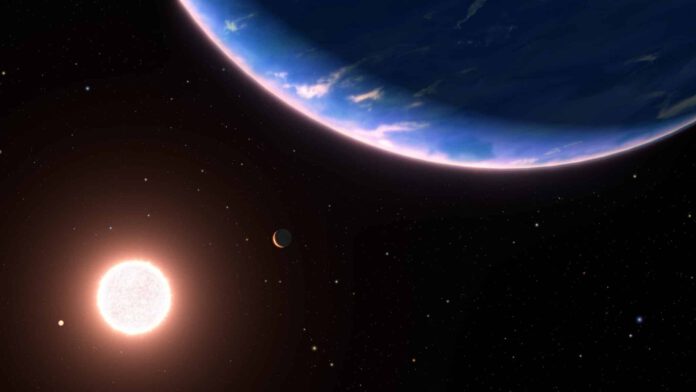
For the first time, scientists have successfully discovered water vapour on a relatively small exoplanet. The astronomers, who were aided by the Hubble Telescope, are extremely excited, although they are not yet entirely sure of the circumstances.
A small exoplanet with a water-rich atmosphere
The planet, GJ 9827d, is approximately twice the diameter of the Earth, and is the smallest planet where a water-rich atmosphere has been found. This discovery suggests the possibility of many more small planets within our galaxy that contain water vapour. GJ 9827d was first discovered in 2017 by the Kepler Telescope. It completes an orbit around a red dwarf star in just over six days, and it is located 97 light years away from the Earth.
A major step in space exploration
“This is the first time we can directly demonstrate that such water-rich planets do indeed exist around other stars,” says researcher Björn Benneke from the Université de Montréal. “This is a significant step in studying how often rocky planets have an atmosphere and what their composition is.”
However, it is still too early to conclude if the Hubble has measured a small quantity of water vapour in a hydrogen-rich atmosphere or if the planet’s atmosphere is primarily composed of water, possibly remained after an old hydrogen-helium atmosphere evaporated due to radiation.
Is water vapour dominant?
“Our observational program was specifically designed not only to find the water molecules in the planet’s atmosphere but specifically to search for water vapour. Any result would be incredible, whether water vapour is dominant or it occurs only in small amounts in a hydrogen-rich atmosphere,” explains head researcher Pierre-Alexis Roy from the Université de Montréal.
First time measurement of a small planet’s atmosphere
Benneke adds: “Until now, we were not capable of directly measuring the atmosphere of such a small planet. Only now it is starting to happen. On such small planets, there should be a certain point after which there is no more hydrogen and they receive an atmosphere that more resembles that of Venus, mainly rich in CO2.”
As hot as Venus
Given that the planet is as hot as Venus – around 425 degrees Celsius – it would still be an inhospitable steaming world even if the atmosphere was primarily composed of water vapour. Researchers are currently on the fence: does the planet still cling to a water vapour saturated vestment, making it a mini Neptune, or is it a warmer version of Jupiter’s moon Europa, which resides under its crust with twice as much water as the Earth?
“The planet GJ 9827d could be half water, half rock. And there could be a lot of water vapour on top of a smaller rocky interior,” explains Benneke.
The formation of the planet
If the planet has a water-rich atmosphere, this would imply that it was formed further away from its star, where it is cold enough for water to freeze. In this scenario, the planet would have eventually moved closer to its star, receiving more radiation, causing the hydrogen to be heated and ultimately escape the weak gravity of the planet. The alternative theory is that the planet formed close to its star, and only traces of water exist in its atmosphere.
The Hubble’s pivotal role
The Hubble Telescope led scientists to the discovery of the water vapour. The space telescope observed the planet for three years during its eleven transits across its star. During this so-called transition, the star’s light is filtered by the planet’s atmosphere, leaving a sort of fingerprint of water molecules that the Hubble can detect. If there are clouds on the planet, they hang low enough not to completely obstruct the Hubble’s view.
The Next Step
The next step will see the even more accurate James Webb Telescope, equipped with its infrared equipment, to further study the atmosphere and examine other present molecules.











